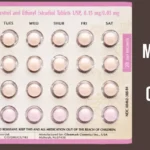
When you first heard about menstrual cups, you might have been intrigued yet a little intimidated. The idea of inserting a cup into the vagina to collect period blood might have seemed overwhelming. But as you learned more about the benefits of menstrual cups, you may have decided to give it a try. However, you quickly realized that inserting the cup correctly was not as easy as you thought. Perhaps you struggled with the cup unfolding too early, not unfolding when already in place, and having difficulty removing it. In this article, we’ll explore how to know if menstrual cup is inserted correctly and what to do if you encounter any problems.
Related: 8 Best Ways To Avoid Pregnancy Naturally
What Is Menstrual Cup & Why Proper Insertion Is Important
A menstrual cup is a flexible cup made of silicone or rubber that is inserted into the vagina during menstruation to collect menstrual fluid. Unlike pads and tampons which absorb the blood, a menstrual cup collects it.
Proper insertion of a menstrual cup is crucial for the following reasons:
- Comfort – Inserting the cup correctly ensures it opens up fully to create a seal and prevent leaks. An incorrectly inserted cup can feel uncomfortable.
- Function – For the cup to collect blood effectively, it needs to open up fully once inside the vagina. Wrong insertion can prevent the cup from opening up properly leading to leaks.
- Safety – Inserting the cup too high or too low can cause discomfort. Inserting it correctly ensures it sits in a comfortable position.
- Longevity – The cup needs to be fully open to create a seal and suction to stay in place. Correct insertion prevents leaks and dislodging ensuring the cup functions optimally for the recommended duration.
The key is to learn the right way to insert a menstrual cup. When done correctly, the cup gets into the right position to collect blood comfortably and securely. Understanding proper techniques can help avoid leaks, discomfort and need for early removal.
Preparing The Cup
Before inserting your menstrual cup, it’s important to take a few preparatory steps to ensure proper usage and hygiene. This will help make the insertion process easier and more comfortable.
Wash Your Hands Thoroughly
The first step is washing your hands with soap and water. Wash for at least 20 seconds, getting between your fingers and under your nails. This removes any dirt or bacteria that could potentially be introduced into the vaginal canal. Keeping your hands clean prevents infections.
Read The Instructions
Though menstrual cups are straightforward to use, each brand has specific guidelines. Take a minute to read the instructions so you know how to use that particular cup properly. This includes details like how to fold, insert, remove, and clean the cup. The instructions also provide sizing guidance and troubleshooting tips.
Fold or Squeeze The Cup
Before inserting the cup, you need to fold or squeeze it to allow for comfortable insertion. There are several fold methods, like the C-fold, punch-down fold, and 7-fold. The instructions will illustrate how to fold that particular cup. Folding it makes the cup smaller so it can be easily inserted into the vaginal canal.
Finding The Right Fold

When inserting your menstrual cup, choosing the right fold is essential for comfortable insertion. There are several common folds that work well for most users:
The C Fold
This is one of the most beginner-friendly folds. Simply fold the cup in half to form the letter “C”. This creates a slim, tapered shape that makes insertion smooth and easy. The C fold works well for those still learning to use a menstrual cup.
The Punch Down Fold
To do the punch down fold, push one side of the rim down into the cup, then push the opposite side down as well, until the cup’s diameter shrinks. This creates a pointed tip which many women find slides in very easily. The punch down is a versatile fold that’s easy to form once you get the hang of it.
The Origami Fold
As the name suggests, this fold uses a series of intricate folds (like the art of origami) to collapse the cup into a very small shape. It takes some practice, but fans of this fold say it allows the cup to open easily once inserted. If you have a very high cervix, the compact origami fold may work better for you.
The 7 Fold
For this fold, press in one side of the cup to flatten that part, then flatten the opposite side and fold the tip down to create a long, thin shape. Named for its resemblance to the number 7, this fold has a tapered end that inserts smoothly. It’s a good choice if the C fold doesn’t seem to be working for you.
S-Fold
This fold is suitable for soft cups like the Diva Cup. Flatten the cup and fold it in half, creating a ‘V’ shape. Gently insert the cup into your vagina, and once it is completely inside, let go of the fold.
E-Fold
This fold is suitable for cups with a wide tip. Flatten the cup and fold it in half, creating a ‘V’ shape. Gently insert the cup into your vagina, and once it is completely inside, let go of the fold.
Triangle Fold
This fold is suitable for cups with a wide tip. Flatten the cup and fold it in half, creating a ‘V’ shape. Gently insert the cup into your vagina, and once it is completely inside, let go of the fold.
Diamond Fold
This fold is suitable for cups with a wide tip. Flatten the cup and fold it in half, creating a ‘V’ shape. Gently insert the cup into your vagina, and once it is completely inside, let go of the fold.
Experiment to find which fold works best for your anatomy. The fold that feels most comfortable and slides in easily is the right one for you. With a little trial and error, you’ll master inserting your cup!
Related: What are the Chances of Getting Pregnant after Stopping Birth Control?
Relaxing The Body
Inserting a menstrual cup for the first time can feel unfamiliar at first. It’s important to help your body relax in preparation for a smooth insertion. Here are some tips:
- Take a few deep breaths before you begin insertion. Deep breathing helps relax the muscles and reduce anxiety. Place one hand on your lower belly and breathe in slowly through your nose, feeling your belly expand. Breathe out slowly through pursed lips. Repeat this breath 3-5 times until you feel your body relax.
- Relax your pelvic floor muscles. The pelvic floor muscles can sometimes tense up, making insertion more challenging. Sit comfortably and consciously relax your pelvic muscles. You may feel a slight lowering sensation as the muscles soften and relax. Avoid actively squeezing or bearing down with these muscles.
- Create a calming environment. Dim the lights, play soft music, or light a candle. A relaxing ambiance helps ease any nervousness.
- Assume a comfortable position. Sit on the toilet with your knees apart or squat. Allow your thighs to gently open so the vaginal canal is angled for easier insertion.
- Massage the vaginal opening. Make small circular motions with clean fingers to relax the vaginal muscles. Apply a water-based lubricant if needed. The lubricant eases insertion.
Relaxing the body helps make inserting a menstrual cup for the first time easier and more comfortable. With practice, your body will become accustomed to using the cup. But always take a moment to breathe and relax the pelvic region before insertion.
Inserting The Cup
The key to inserting a menstrual cup comfortably is to relax. Start by getting into a comfortable position, whether sitting on the toilet or standing with one foot on the toilet seat or squatting.
Take a few deep breaths to relax your body. Be patient with yourself as inserting a cup takes practice.
Hold the cup with the folded side first and aim it slightly downward, toward your tailbone or small of your back. Gently insert the cup at an angle, not straight up and down. Inserting at an angle follows the natural angle of the vaginal canal.
Slide the cup in slowly, allowing your vaginal muscles to relax around it. If you meet resistance, don’t force it. Stop, take a breath, re-angle the cup and try again. The cup should glide in easily when inserted correctly at the right angle.
Push the cup in as far as it will comfortably go, until just the stem is exposed. Give the base of the cup a gentle nudge with a finger if needed. The cup sits low in the vaginal canal, not high up like a tampon.
Opening The Cup
Once the cup is fully inserted, it’s important to make sure it has opened properly to form a seal with your cervix. This prevents leaks and ensures comfort.
After insertion, give the cup a few minutes to open up on its own. The cup is designed to pop open once inside the vaginal canal. You may feel a slight popping sensation when this happens.
If you don’t feel the cup open or are unsure, gently twist or rotate the cup from base or stem. This will allow the cup to fully open if it hasn’t already. The cup should open up easily – do not force it. Forcing the cup can cause discomfort.
Rotating the cup 360 degrees will ensure it has opened to form a tight seal with your vaginal walls. The cup needs to be fully open all the way around.
An opened cup will feel round and smooth, with the walls pushed out. It should not feel pointed or collapsed. If it still feels closed, gently run your finger around the upper rim to confirm the seal.
Once open, your cup should move very little. You shouldn’t feel it at all when walking or moving. If you feel any discomfort, the cup may not be fully open or sealed. Try rotating it again until it feels secure and comfortable.
How To Know If Menstrual Cup Is Inserted Correctly
Checking Placement
Once you’ve inserted your menstrual cup, it’s important to check that it’s opened up correctly and positioned properly inside your vaginal canal. Here are some tips for checking your cup’s placement:
- Make sure the cup has fully popped open. Cups are designed to open up into the shape of a bell once inside your body. Run your finger around the base of the cup to feel that it has completely unfurled and opened up. The rim should feel smooth and round.
- Check that the stem is not sticking out. Most menstrual cups have a little stem on the bottom. Make sure you don’t feel the stem protruding out of your vaginal opening. You may need to push the cup in a little deeper.
- Don’t feel any part of the cup itself. When a menstrual cup is inserted correctly, you shouldn’t be able to feel it at all. The cup should sit high up near your cervix, out of the way. If you can feel the firmness of the cup against your vaginal walls, it means it’s not fully opened or pushed in far enough.
- Bear down. Try gently bearing down or pushing like you’re going to pass a bowel movement. This will allow you to feel if any part of the cup is sticking out where it shouldn’t be. You shouldn’t feel any hardness or resistance.
- Walk around. Take a few steps, squat up and down, or go up and down some stairs. This allows you to feel if the cup is positioned right so it moves with your body. You shouldn’t feel any slipping or leaking.
If you find the stem is irritating you or sticking out, you can trim it shorter. The stem is just there to help you remove the cup – once it’s opened up inside you, it’s not needed. Getting the placement right can take some practice, so don’t worry if it takes a few cycles to get the hang of it!
Creating A Seal
Once the cup is inserted, it’s important to check that there is a good seal preventing leaks. Here are some tips for creating a tight seal:
- Run your finger around the rim of the cup. You should be able to feel the cup opening has fully popped open, and there are no gaps or folds in the rim.
- Gently tug down on the base of the cup. There should be strong suction and resistance when you try to pull down. Don’t tug too forcefully.
- Walk around and go about normal movements. The cup should stay securely in place. If you feel any leaking or feel the cup start to slip, it likely isn’t sealed properly.
- Bear down like you are having a bowel movement. This can help the cup fully open and form a tight seal with your vaginal walls.
- Rotate the cup slightly back and forth. This can help the cup fully open if inserted at a slight angle.
- Run your finger around the base of the cup to check for leaks. It should feel dry with no fluid on the cup or vaginal walls.
The seal is one of the most important parts of using a menstrual cup correctly. Take your time to ensure the cup has fully opened and formed a tight seal after insertion. If leaks occur, try removing the cup and reinserting. With some practice, you’ll get the hang of creating a dependable leak-proof seal.
Related: True Stories of Pregnancy after Tubal Ligation
Troubleshooting Issues
Using a menstrual cup takes some getting used to. Here are some common issues that can occur and how to troubleshoot them:
Leaking
Leaking is one of the most common problems when starting to use a menstrual cup. Here are some tips to prevent leaking:
- Make sure the cup is fully opened and forming a seal against your vaginal walls. Run your finger around the cup to feel if it has fully popped open.
- Check that the cup is inserted high enough. It should sit just below your cervix. If placed too low, it may not catch all the blood flow.
- Consider switching to a smaller cup if you have a light flow, or a larger cup if you have a heavy flow. The cup needs to be filled to its capacity to prevent leaking.
- When inserting, give the cup a gentle twist to create a better seal.
- Make sure the cup holes or vents are not blocked or clogged. Clean them out if needed.
If you notice leaking after trying these tips, it may be time to change your cup on a more frequent basis.
Discomfort
Some women experience discomfort when using a menstrual cup. Here are some tips for minimizing any pain or irritation:
- Use water-based lube to ease insertion and removal. Avoid silicone-based lube as that can deteriorate the silicone cup.
- Trim the stem if it is irritating the vaginal opening. You can still grasp the base of the cup well without the stem.
- Ensure the cup is fully opened so the vaginal walls are not compressed.
- Consult with your gynecologist if you have severe pain with use. You may need a smaller cup or to address an underlying condition like vaginismus.
Unable To Remove
It can be worrying the first few times you need to take out your menstrual cup. Here are some tips for easy removal:
- Relax by doing deep belly breaths before attempting to remove it. Being tense will make it harder.
- Gently bear down with your pelvic muscles, as if passing a bowel movement. This will lower the cup enough to reach it.
- Try different folds or positions for removal like squatting over the toilet.
- Do not panic or tug harshly. This can create suction making it harder to grasp.
- Try running your finger around the base to gently break the seal before removing.
- Add a few drops of water into the cup to help weaken the seal.
Be patient with yourself as you get used to the process. Consult a doctor if you are still unable to remove it after multiple attempts.
Related: Weight Gain after Stopping Birth Control
How do you ensure menstrual cup is inserted correctly?
To ensure that your menstrual cup is inserted correctly, you should follow these steps:
- Wash your hands thoroughly before insertion.
- Fold the cup using one of the recommended folding methods.
- Relax your vaginal muscles and insert the cup into your vagina.
- Once the cup is inside, rotate it or tug on the stem to ensure that it has fully opened and created a seal against the vaginal walls.
- Check that the stem is positioned comfortably inside the vagina and that you cannot feel it when you sit down or walk.
- If you feel any discomfort or pain, you may need to adjust the cup’s position or try a different size.
How to insert a menstrual cup for beginners?
To insert a menstrual cup for beginners, you should follow these steps:
- Wash your hands thoroughly before insertion.
- Fold the cup using one of the recommended folding methods.
- Relax your vaginal muscles and insert the cup into your vagina.
- Once the cup is inside, rotate it or tug on the stem to ensure that it has fully opened and created a seal against the vaginal walls.
- Check that the stem is positioned comfortably inside the vagina and that you cannot feel it when you sit down or walk.
- If you feel any discomfort or pain, you may need to adjust the cup’s position or try a different size.
- To remove the cup, wash your hands thoroughly and gently pull on the stem until you can reach the base of the cup. Pinch the base to release the seal and remove the cup.
How to open menstrual cup inside?
To open a menstrual cup inside, you should follow these steps:
- Insert the cup into your vagina using one of the recommended folding methods.
- Once the cup is inside, use your finger to feel around the base of the cup to check if it has fully opened.
- If the cup has not fully opened, try twisting it or pulling it down and reinserting it.
- You can also try running your finger around the cup’s base to check for any dents or folds.
- If you feel any dents or folds, you can try twisting the cup or pulling it down and reinserting it.
How to remove menstrual cup?
To remove a menstrual cup, you should follow these steps:
- Wash your hands thoroughly before removal.
- Relax your vaginal muscles and gently pull on the stem until you can reach the base of the cup.
- Pinch the base of the cup to release the seal and remove the cup.
- Empty the contents of the cup into the toilet or sink.
- Rinse the cup with water and reinsert or store it in a clean, dry place.
How to insert a menstrual cup without pain?
To insert a menstrual cup without pain, you should follow these steps:
- Wash your hands thoroughly before insertion.
- Relax your vaginal muscles and take deep breaths to help you relax.
- Use a water-based lubricant to help the cup slide in more easily.
- Fold the cup using one of the recommended folding methods.
- Insert the cup into your vagina at a slight angle, aiming towards your tailbone.
- Once the cup is inside, rotate it or tug on the stem to ensure that it has fully opened and created a seal against the vaginal walls.
- Check that the stem is positioned comfortably inside the vagina and that you cannot feel it when you sit down or walk.
- If you feel any discomfort or pain, you may need to adjust the cup’s position or try a different size.
When To Consult A Doctor
Using a menstrual cup is generally safe, but there are a few situations when you should see your doctor for help:
Unbearable Pain
Most women feel some discomfort when first using a menstrual cup as the body gets used to having it inside. However, the pain should not be unbearable. If you have intense, persistent pain that pain medication does not help, consult your doctor. They can examine you, determine if the cup is positioned correctly or if something more serious is wrong. Don’t try to tough it out with severe menstrual cup pain.
Unable To Reach The Cup
You should always be able to reach the base of the menstrual cup to break the seal and remove it. If your fingers cannot reach the cup at all, do not attempt to dig around for it. Make an appointment with your gynecologist promptly. They have tools to safely and effectively remove it.
Signs Of Toxic Shock Syndrome
Toxic shock syndrome is a rare but dangerous infection that has been linked to menstrual cup use in a few cases. Symptoms include sudden high fever, low blood pressure, rash, vomiting, diarrhea and other flu-like signs. Remove the cup immediately if TSS is suspected. Prompt medical treatment is needed, so do not wait to see if it resolves on its own. TSS can escalate rapidly, but early intervention greatly improves the chances of recovery.
Related: Acne after Stopping Birth Control
Conclusion
In conclusion, understanding how to know if a menstrual cup is inserted correctly is essential for a comfortable and effective experience. Common problems, such as the cup unfolding too early or not unfolding when in place, can be addressed by trying different insertion techniques, such as the C-fold. As more individuals embrace menstrual cups, open discussions about menstrual and reproductive health are encouraged, leading to increased awareness and support.
Research has shown that menstrual cups, when used correctly, are a safe and well-tolerated alternative, with adaptability increasing through proper counseling, peer support, and practice. By providing comprehensive information and support, menstrual cups can offer a sustainable and comfortable option for individuals seeking an eco-friendly and reliable menstrual hygiene product.
Frequently Asked Questions (FAQs)
How do you know if you put your menstrual cup in right?
To know if you have inserted your menstrual cup correctly, you should not feel any discomfort or pain. The cup should be fully open and create a seal against the vaginal walls to prevent leaks. You can check if the cup is fully open by running your finger around the cup’s base. If you feel any dents or folds, you can try twisting the cup or pulling it down and reinserting it. The stem of the menstrual cup should be positioned comfortably inside the vagina, and you should not feel it when you sit down or walk. If you feel any discomfort or pain, you may need to adjust the cup’s position or try a different size.
Can a menstrual cup be inserted wrong?
Yes, a menstrual cup can be inserted incorrectly. If the cup is not inserted far enough, it may not create a seal against the vaginal walls, leading to leaks. If the cup is inserted too far, it may be difficult to remove. It is important to follow the instructions carefully and ensure that the cup is fully open and positioned comfortably inside the vagina.
Should I feel my menstrual cup when I sit down?
No, you should not feel your menstrual cup when you sit down. If you feel any discomfort or pain, you may need to adjust the cup’s position or try a different size. The stem of the menstrual cup should be positioned comfortably inside the vagina, and you should not feel it when you sit down or walk
Where should the stem of my menstrual cup be?
The stem of the menstrual cup should be positioned comfortably inside the vagina, and you should not feel it when you sit down or walk. If you feel any discomfort or pain, you may need to adjust the cup’s position or try a different size. Some people prefer to trim the stem to a shorter length if it feels too long.
How to tell if menstrual cup is too big?
If your menstrual cup is too big, you may experience discomfort or pain during insertion or removal. You may also feel pressure or a sensation of fullness when the cup is inside. If the cup is too big, it may not create a seal against the vaginal walls, leading to leaks. If you are having difficulty inserting or removing the cup, or if you experience any discomfort or pain, you may need to try a smaller size.
Can’t get menstrual cup in far enough. What should I do?
If you are having difficulty inserting your menstrual cup, you may need to try a different folding method or use a water-based lubricant to help the cup slide in more easily. You can also try inserting the cup at a slight angle, aiming towards your tailbone. If you are still having difficulty, you may need to relax your vaginal muscles and take deep breaths to help you relax.






